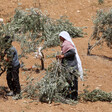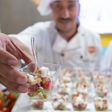Rights and Accountability 16 December 2023

A press vest is laid atop the bodies of Palestinian journalists Sari Mansour and Hassouneh Salim in Deir al-Balah in the Gaza Strip on 19 November.
APA imagesAn Israeli drone attack killed an Al Jazeera cameraman and injured the network’s bureau chief in the Gaza Strip on Friday.
The Israelis fired the missile that injured Wael al-Dahdouh and cameraman Samer Abu Daqqa after they were dispatched to the Farhana school amidst calls for rescue from injured and besieged Palestinians trapped there.
While al-Dahdouh managed to reach paramedics on foot, Abu Daqqa’s injuries prevented him from doing so. Israel obstructed ambulances from reaching him as he lay on the ground for hours bleeding to death.
Israel’s killing of Samer Abu Daqqa is the latest in its apparently deliberate and systematic attacks on Palestinian journalists and their families. With Abu Daqqa’s death, the number of journalists and media workers killed during Israel’s genocidal war has exceeded 90, according to Al Jazeera.
“Return to Samer”
Speaking from his hospital bed, al-Dahdouh explained that he and Abu Daqqa had been covering the evacuation of a Palestinian family from the school alongside an ambulance, with prior coordination.
“We reached certain locations that no camera lens had reached since the ground invasion. Even civil defense and ambulances had not reached those places.”
After concluding his reporting, al-Dahdouh was walking over a distance of several dozen meters – since vehicles couldn’t reach the area due to the level of destruction – when he felt that “something big had happened” that threw him to the ground.
Al-Dahdouh said he tried to regain his strength to seek shelter as he anticipated another missile strike would follow. Realizing the severity of his bleeding arm, al-Dahdouh pressed it and opted to keep walking.He eventually spotted paramedics and signaled to them, but they were unable to reach him. The correspondent walked until he got to them, received first aid and was taken to hospital.
“I asked them to return to Samer,” al-Dahdouh said.
“But the paramedics said that we had to leave immediately and send another vehicle to the location to avoid all of us becoming targets, and we arrived at the hospital.”
Al Jazeera reported that “by the time he reached an ambulance, medics said they could not return to the site of the attack because it was too dangerous.”
“Following Samer’s injury, he was left to bleed to death for over five hours as Israeli forces prevented ambulances and rescue workers from reaching him, denying the much-needed emergency treatment,” according to Al Jazeera.
Al-Dahdouh told the network that one ambulance tried to reach Abu Daqqa but the Israelis fired at it.
The live broadcast showed al-Dahdouh shortly after he arrived at the hospital. He urged medics and journalists around him to go back and rescue Abu Daqqa.
“Samer was screaming, coordinate with the Red Cross, get someone to bring him.”
Al-Dahdouh displayed the same dignity and determination he had shown when Israel killed his wife, son, daughter and grandson in Nuseirat refugee camp, central Gaza Strip, on 25 October.
“This is a preliminary message despite the wounds,” he said from his hospital bed.
“I will try to regather myself and my strength to continue what we started from the beginning of the war, and despite everything I expect to meet you tomorrow morning live on air.”
This was also not the first time Wael al-Dahdouh had been injured by Israeli forces while reporting. He was struck in the arm by bullet shrapnel while covering Gaza’s Great March of Return protests in May 2018.
A choice to stay in Gaza
Al Jazeera’s managing editor Mohamed Moawad described Samer Abu Daqqa as “not just a skilled professional but a compassionate soul who understood the power of visual storytelling.”
His “lens captured the raw and unfiltered reality of life in Gaza,” and his “courage in the face of adversity allowed the world to witness the untold stories” of the region.
Friends and colleagues mourned Abu Daqqa and remarked on his dedication to covering Israel’s genocide in Gaza.
Abu Daqqa had the opportunity to work in Belgium with Al Jazeera but chose to live in Gaza and convinced his family to come back to Gaza as well, his colleague Tamer al-Mishal recounted.Systematic attacks
The Committee to Protect Journalists called for an international probe into the attack, which it says was “a result of a missile launched from what is believed to be an Israeli drone.”
“Al Jazeera aired footage of al-Dahdouh wearing his press vest and assured in its reporting that he was taking precautions and was identifiable as a member of the press,” the Committee to Protect Journalists said.
But press vests don’t seem to provide the intended protection to Palestinian journalists.
Last month, Palestinian reporter Hind Khoudary told The Electronic Intifada that she and others chose not to wear their press vests or carry press gear due to the fear of becoming targets when forcibly displaced from northern Gaza to the south.
Al Jazeera said it “holds Israel accountable for systematically targeting and killing Al Jazeera journalists and their families.”
On Monday, an Israeli airstrike killed the 90-year-old father of Al Jazeera reporter Anas al-Sharif. This came after al-Sharif had received threats from Israeli military officers by telephone.
Attacks on journalists
Israel’s attacks on journalists also extend to the occupied West Bank.
Israeli forces “violently attacked” Anadolu Agency photojournalist Mustafa Alkharouf in occupied East Jerusalem on Friday while he was on reporting duty.
Israeli police “first pulled their weapons at Alkharouf, who was covering the news, and then threw him to the ground, beating and kicking him while he was on the ground,” the Turkish news agency said.
“The physical attack on Mustafa Alkharouf is not a singular incident,” CPJ Program Director Carlos Martínez de la Serna said.
“It belongs to a pattern of physical attacks, assaults, and threats by Israeli soldiers and settlers on journalists reporting from the West Bank and Israel that have dramatically increased since 7 October.”
CPJ says it has been able confirm the deaths of at least 57 Palestinian and three Lebanese journalists.Israel’s attacks on journalists also extend to “assaults, threats, cyberattacks, censorship and killings of family members,” CJP added.
This is the “deadliest month for journalists since CPJ began gathering data in 1992,” the group said.
Despite the ongoing attacks against them, Palestinian journalists have remained determined in persistently covering Israel’s extermination campaign.




